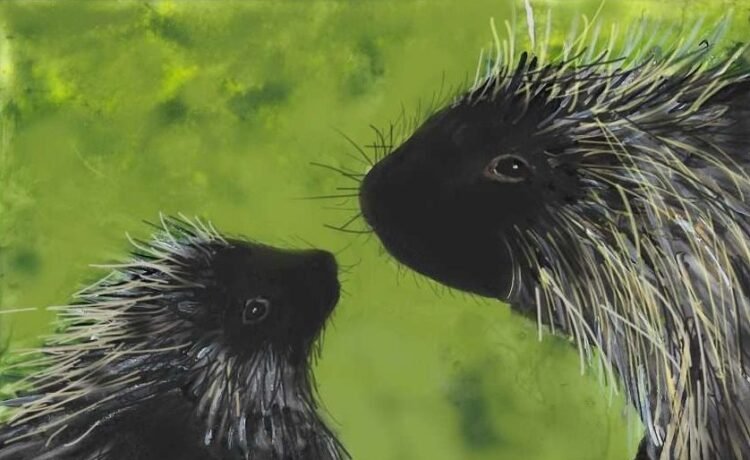
 Last week, during a walk in the woods, I turned towards soft sounds in the understory and saw a small porcupine waddling through fallen oak and maple leaves. Porcupines have terrible eyesight and can’t see more than several feet in front of them, so I was able to quietly watch this one for a few moments.
Last week, during a walk in the woods, I turned towards soft sounds in the understory and saw a small porcupine waddling through fallen oak and maple leaves. Porcupines have terrible eyesight and can’t see more than several feet in front of them, so I was able to quietly watch this one for a few moments.
As the porcupine continued meandering along, it caught my scent and suddenly stilled before lifting up its forelegs and rising onto its haunches, nose in the air.
It was hardly an intimidating gesture, but I got the message and didn’t want to startle it further, so I moved down the path and let it continue moseying in peace.
Young porcupines are dispersing from their mothers this time of year, and with that, leaving behind the cutest name for a baby animal – porcupette – as they strike out on their own.
Porcupettes are born in May or June, after a 7-month gestation period. The dedicated mom-of-one (or, rarely, two) spends the next few months nursing.
In July I was delighted to find a mother porcupine and her porcupette munching on clovers in my backyard. I like to think the one I spotted the other day is the same young porcupine, now venturing out on its own.
Winter comes with a number of challenges for porcupines, and the young ones must learn to navigate these on their own. This time of year, securing food and shelter are top priorities.
Porcupines find pre-made dens in tree cavities and rock outcroppings to spend the winter, only traveling short distances to eat from nearby trees.
In a 2011 study, the porcupine biologist Uldis Roze found that during years of average snowfall, winter ranges for porcupines were about 11 percent the size of summer ranges; in years with little to no snow, ranges remained larger
throughout the season.
Porcupines’ short legs make moving through snow slow-going, but their quills, modified hairs made of keratin, protect them despite the animals’ leisurely pace.
Although a quick web search will suggest an individual porcupine has around 30,000 quills, in a 2017 paper delightfully titled “Getting to the Point: How Many Quills Does a North American Porcupine Have?” researcher John Shokeir discovered that one porcupine had 44,006 quills.
Quills harden within an hour of birth and deter all but the wiliest predators.
Fishers, which regularly predate porcupines, attack the prickly animals’ faces first, disorienting a porcupine enough to flip it over and get at its unprotected underside. American martens use the sneak-attack approach of tunneling under snow to get to the same vulnerable underbelly area on young porcupines.

 Porcupines seek safety – and food – in trees. White pine and eastern hemlock are their preferred food species, and these trees’ rough-textured bark makes for easier climbing compared to the smooth trunks of beech and birch.
Porcupines seek safety – and food – in trees. White pine and eastern hemlock are their preferred food species, and these trees’ rough-textured bark makes for easier climbing compared to the smooth trunks of beech and birch.
Although porcupines feast on leaves, flowers, and fruits in summer, their diet shrinks to twigs, needles, and the cambium, or inner bark, of conifers – and a few hardwood species – in winter.
Porcupines have a large cecum, a digestive sac in their intestines, which allows them to ferment cellulose and extract nutrients from this harsh diet. It’s no walk in the park – or field of clover. In one study, Roze found that his research subjects lost an average of 17 percent of their body weight over the winter.
Porcupines’ winter forage is generally high in potassium but low in sodium, so they need to seek out salt to maintain the right internal balance of these minerals – a drive that brings them out of the relative safety of their home ranges, and sometimes into residential areas to lick road salt from tires, tools, and even buildings.
If you see a small porcupine in the coming weeks, know that it might be gearing up for its first winter. This time of year, porcupines are likely to be gorging on late season forage such as apples and acorns to pack on the pounds, or sniffing around den sites.
While we get to spend the harshest days of winter cozied up by the fire with bowls of soup, young porcupines have no such luxury – they’ll be hunkered down in their dens, gnawing away on bark until spring comes.
After the snow melts, I hope to see the porcupine I came across again and offer it silent congratulations for making it through the toughest season.
Catherine Wessel is the assistant editor at Northern Woodlands. Illustration by Adelaide Murphy Tyrol. The Outside Story is assigned and edited by Northern Woodlands magazine and sponsored by the Wellborn Ecology Fund of New Hampshire Charitable Foundation: nhcf.org.
Read more about porcupines in New York State.








Recent Comments